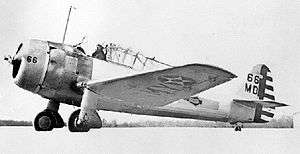Fleetwings BT-12 Sophomore
| BT-12 Sophomore | |
|---|---|
 | |
| The XBT-12 | |
| Role | Basic trainer |
| National origin | United States |
| Manufacturer | Fleetwings |
| First flight | 1939 |
| Primary user | United States Army Air Forces |
| Produced | 1942-1943 |
| Number built | 25 |
|
| |
The Fleetwings BT-12 Sophomore, also known by the company designation Model 23, was a 1940s all-metal basic training monoplane built by Fleetwings for the United States Army Air Forces. Only 24 production examples of the type were built before the contract was cancelled.
Design and development
With the outbreak of the Second World War, the United States Army Air Corps (later U.S. Army Air Forces) was ill-prepared for a major war. In an effort to obtain as many aircraft as possible the USAAF contracted Fleetwings, a specialist fabricator of sheet stainless steel,[1] to produce a basic training monoplane. A prototype Model 23 was ordered as the XBT-12 during 1939.[2]
The XBT-12 was an all-metal low-wing cantilever monoplane with a fixed tailwheel landing gear and powered by a Pratt & Whitney R-985 engine. The aircraft had two identical tandem cockpits for instructor and pupil covered by a continuous canopy. It was the first military aircraft to be constructed primarily from welded stainless steel.[3]
Operational history
After evaluation of the XBT-12 starting in late 1939,[4] an order for 176 production aircraft, designated BT-12, was placed.[5] Only 24 aircraft were delivered, one in 1942 and 23 in 1943,[6] before the contract was cancelled,[2] the Vultee BT-13 being preferred.[1]
Variants
- XBT-12
- Army designation for the prototype Model 23, one built.
- BT-12
- Army designation for the production Model 23, 24 built, 152 cancelled.
Operators
Specifications (BT-12)
Data from The Illustrated Encyclopedia of Aircraft (Part Work 1982-1985), 1985, Orbis Publishing; also [4]
General characteristics
- Crew: Two (pilot and instructor)
- Length: 29 ft 2 in (8.89 m)
- Wingspan: 40 ft (12 m)
- Height: 11 ft 4 in (3.45 m)
- Wing area: 240.4 sq ft (22.33 m2)
- Empty weight: 3,173 lb (1,439 kg)
- Gross weight: 4,497 lb (2,040 kg)
- Powerplant: 1 × Pratt & Whitney R-985-AN-1 Wasp Junior radial engine, 450 hp (340 kW)
Performance
- Maximum speed: 195 mph (314 km/h; 169 kn)
- Cruise speed: 150 mph (130 kn; 241 km/h)
- Range: 675 mi (587 nmi; 1,086 km)
- Service ceiling: 23,800 ft (7,254 m)
- Time to altitude: 10 minutes to 10,000 feet
See also
- Aircraft of comparable role, configuration and era
- Related lists
References
| Wikimedia Commons has media related to Fleetwings BT-12 Sophomore. |
- Notes
- 1 2 Pattillo, Donald M. (2001). Pushing the Envelope: The American Aircraft Industry. Ann Arbor, MI: University of Michigan Press. p. 131. ISBN 978-0472086719.
- 1 2 Gunston, Bill (1994). World Encyclopaedia of Aircraft Manufacturers. Annapolis, MD: Naval Institute Press. p. 118. ISBN 978-1557509390.
- ↑ Pitkin, Walter (1942). What's That Plane?: The Handbook for Practical Aircraft Identification (2nd ed.). New York: Penguin Books. p. 60. ASIN B001DEMTMO.
- 1 2 Historical Office of the Army Air Forces (1947). The official pictorial history of the AAF. New York: Duell, Sloan and Pierce. p. 177. ASIN B000GU84Z2.
- ↑ Andrade, John (1979). U.S. Military Aircraft Designations and Serials since 1909. Leicester, UK: Midland Counties Publications. p. 61. ISBN 0-904597-22-9.
- ↑ Trimble, William F. (1982). High Frontier: A History of Aeronautics in Pennsylvania. Pittsburgh, PA: University of Pittsburgh Press. pp. 217–218. ISBN 0-8229-5340-4.
- Bibliography
- The Illustrated Encyclopedia of Aircraft (Part Work 1982-1985), 1985, Orbis Publishing
Further reading
- Baker, David (October 1943). "Design Analysis of the Fleetwings BT-12". Aviation. pp. 119–132, 356. (registration required (help)).